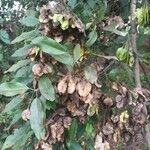Leaves opposite or subopposite, often borne on short shoots; lamina usually c. 2–7 x 1–4·5 cm., from very narrowly elliptic to very broadly obovate or subcircular (especially on sucker shoots when they may be as much as 5·5 cm. broad and broader than long), from densely tomentose to nearly glabrous (except for scales), densely golden-(rarely silvery-)lepidote beneath, scales usually contiguous but sometimes hidden by the indumentum, apex sometimes acute but often rounded or even retuse, base cuneate to rounded; lateral nerves usually only 3–4(5) pairs, prominent beneath; petiole up to 5 mm. long.
A small tree. It can be up to 11 m tall, but is often 3-5 m tall. The trunk is often crooked and can be 23 cm across. The leaves can be oval or heart shaped. The leaves are 1.9-5 cm long by 1.3-2.5 cm wide. The are dark green and shiny above and yellow-green underneath. Often there are dense velvety hairs underneath. The flowers are small and white or greenish-yellow. They occur in long spikes. The fruit are 2.5 cm long by 1.9 cm wide. They have 4 wings. They are bright red.
Inflorescences of short rather congested spikes up to c. 3 cm. long, occasionally branched, axillary, often appearing on leafless branchlets in the axils of the scars of the fallen leaves; rhachis tomentose to glabrous (except for scales); bracts 3 mm. long, filiform, often somewhat persistent.
Small tree up to 9(12) m. high or more rarely a shrub, often with arching stems, frequently flowering before the leaves; crown dense, irregular; bark creamy-grey to grey-black, fissured; branchlets usually tomentose to densely pubescent when young but often quickly glabrescent.
Fruit usually c. 2 x 2 cm. but sometimes smaller and occasionally up to 3·5 x 3·5 cm., subcircular in outline, densely reddish-or golden-lepidote, apical peg absent or very short, wings c. 5(10) mm. wide, subcoriaceous, stipe up to 11 mm. long.
Scales irregularly undulate in outline, marginal cells 8–12 mostly retusely scalloped, delimited by usually 8 radial walls, 8 tangential walls and sometimes a few extra radial walls.
Lower receptacle 2·3–3 mm. long; upper receptacle 2·5–3 x 2–3 mm., campanulate or shortly infundibuliform, lepidote and otherwise pubescent to nearly glabrous.
Petals 1·5–2·5 x 1–2·5 mm., broadly to very broadly obovate or subcircular or very broadly transversely elliptic, emarginate, shortly unguiculate, glabrous.
Small tree or shrub, up to 9 m high. Fruit 20 mm long, russet-coloured. Flowers yellow; August to January. Tree or shrub savanna.
Cotyledons 2 1·5 x 2·5 cm., transversely elliptic, arising above soil level; petioles 10–11 mm. long.
Disk c. 2 mm. in diam. with pilose margin free for 0·7–0·8 mm.
Stamen-filaments 3–1·5 mm. long; anthers 0·4–0·6 mm. long.
Style 3·5–4·5 mm. long, not expanded at the apex.
Sepals 1–1·5 x l–1·5 mm., deltate.
Flowers sessile, yellow.


